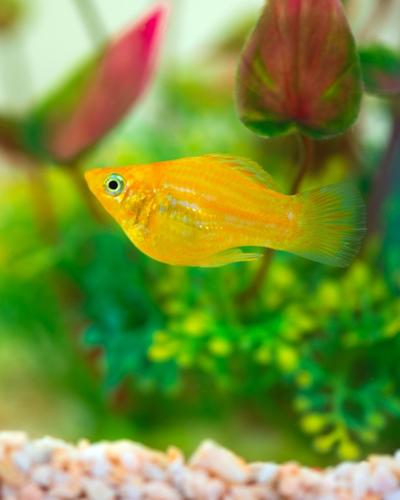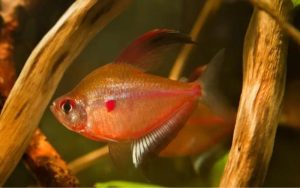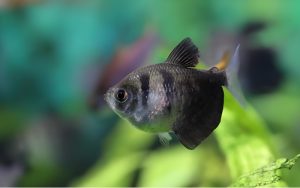Are you interested in bringing some Molly Fish into your home aquarium? But what is the average molly fish lifespan?
These popular livebearers are an excellent choice for any aquarist, from novice to expert – but the key to keeping them healthy and ensuring their extended lifespan is proper tank setup and maintenance.
In this blog post, we’ll cover everything you need to know about Molly Fish care: from selecting the best tank size and parameters through water changes and other essential upkeep.

Read on for our complete mollies fish lifespan beginner’s guide, plus advice from experienced freshwater fish keepers!
Table of Contents
ToggleAre Mollies Easy to Keep Alive?
Yes, mollies are easy to keep alive and make great aquarium pets for the beginner aquarist. Mollies come in various colors and shapes, making them an attractive addition to any tank.
In terms of molly fish tank requirements, mollies are very low-maintenance fish that can tolerate most water conditions (such as molly ph level and tank water temperature).
They only need a consistent diet molly fish of algae-based foods, including flakes, frozen food, or live food such as brine shrimp or bloodworms.

Mostly, mollies do well in groups since they’re social fish.
However, some females may become territorial with other tank mates if there is too small of an aquarium or if overcrowding occurs in the Molly tank.
So be sure to provide ample room for swimming and hideaways when setting up your fish tank with multiple mollies!
In terms of compatibility, molly fish get along well with other peaceful fish species such as guppies and platys—meaning they won’t pick on tank mates molly fish like more aggressive species might do (so long as it isn’t another male and female molly).
Overall, due to their hardiness and generally low maintenance needs—mollies are easy to keep alive, even for beginners who don’t have extensive experience setting up tanks or caring for aquatic life!
How Long Do Mollies Live in a Tank? (Molly Fish Lifespan)
How long do black mollies live in home aquarium? Mollies make great beginner aquarium pets due to their hardy nature and low maintenance requirements.
Although the life expectancy of molly fish is three-five years, with proper care and maintenance, they can easily live much longer.
Here are some essential tips for ensuring your Molly Fish have a long and healthy life in your aquarium:
1. Provide them with a large enough tank. The minimum size for a tank with mollies is 20 gallons, but you may need more depending on the number of fish.
2. Add ample hiding spots and decorations that provide plenty of places to take refuge in case they feel threatened or stressed from overcrowding. This can also help reduce aggression amongst female mollies.
3. Keep the water parameters and temperature consistent by testing them regularly, as drastic changes in conditions can cause problems for your fish.
4. Adequately feed your mollies with various foods, including flake, frozen, algae wafers, or molly fish live foods like bloodworms.
What Affects Your Mollies Fish Lifespan?
All desirable situations have negative consequences. The same goes for the moly fish; the occurrence of other determinants contributing towards their unusually long mollies lifespan may cause premature death.
There are also certain factors in the duration of molly fish consumption:
1. Quality of water: Mollies need clean and stable water parameters, such as pH and temperature, to remain healthy. Poorly maintained water can reduce your mollies lifespan.
2. Diet: A lack of a balanced diet will result in unexpected death or diseases in this fish species.
3. Stress: Overcrowding and aggressive tank mates mollies can also cause mollies to become stressed, which can lead to a decreased the lifespan of molly fish.
4. Disease: Some common diseases that molly fish are prone to include ich, velvet, and fin rot, which can potentially shorten a fish’s life if left untreated.
By keeping these factors in mind when setting up your tank and caring for your mollies, you can ensure your molly fish live as long as possible!
How Big Can Molly Fish Get?
Molly fish size chart typically ranges from 3-6 inches (8-15 cm). However, some species can grow up to 8 inches (20 cm) in length.
Molly fish size, cm, and inches can also depend on their environment and diet. They will likely reach their maximum size if they are well-cared for, fed with quality fish food, and kept in appropriate tank size.
On the other hand, if kept in an overcrowded tank or improperly fed, their growth will be stunted, and their lifespan can be shortened.
So, when setting up your molly aquarium, ensure ample space and quality food so they can reach their maximum size!
Also, remember that the larger Molly specimens may become more aggressive if not given enough space or natural hiding spots.
How Many Mollies Should Be Kept Together?
How many molly fish per gallon? Generally speaking, a minimum of one gallon per fish is recommended for molly fish to ensure they have enough room to swim and thrive.
It’s also important to note that the number of mollies you can keep in an aquarium depends on the size of your tank and the type of mollies you are keeping.
For example, keeping large molly species is best to keep up to two or three fish per 10 gallons of water.
How Big of a Tank Does a Molly Need?
For various types of molly fish, an aquarium size with a capacity ranging from 20 to 55 gallons is best.
A larger tank will provide more room for the beautiful and diverse species that these majestic creatures come in!
When setting up a tank for molly fish, consider the number of fish being kept and the type of molly fish tank setup you’re trying to achieve.
If you are planning on fish keeping several fish, then it is best to opt for a giant aquarium with more hiding spots and decorations. This will give your mollies the best environment for their long-term health.
On the other hand, if you’re keeping only a few mollies, then a 20 to 30-gallon tank should suffice.
Habitat and Tank Requirements
Mollies exist within rivers, lakes, swamps, river basins, wetlands, or shallow waters. The fish can tolerate greater temperatures as well as softer ph.
You should maintain the molly habitat to ensure they can flourish in captivity. Foliage on Molly tanks is essential; plants can be secured to a thin sand surface.
Mollies should only spend a little time inside the tank and avoid damaging loose roots.
What Ph Do Mollies Like?
Molly fish ph level can range from 7.0 to 8.5, with the optimal level being 7.8 or higher.
If the water pH is too low (below 7.0), it can be difficult for your mollies to stay healthy, and their lifespan could be shortened if they are not moved to waters with a more suitable molly ph level.
It’s essential to keep in mind that the pH of your aquarium should constantly be monitored, especially if you are keeping mollies, as they tend to be more sensitive to water quality.
By maintaining an appropriate pH balance for your tank, you can ensure that your mollies stay healthy and live a long and fulfilling life.
Water Conditions
As with every freshwater species, they are maintaining good and consistent conditions is essential to ensuring that Molly fish remains happy and healthy.
The ideal temperature for mollies is between 76-82°F (24-28°C). Ammonia and nitrite levels must be kept as close to zero as possible, while nitrate levels should not exceed 40 ppm.
It’s also essential to perform regular water changes of 25% every two weeks to prevent ammonia and nitrite spikes that can harm your fish.
Finally, keep in mind that mollies do best in an aquarium with low levels of current and plenty of hiding spots so they can feel comfortable.
Preventing and Treating Diseases
You cannot guarantee that the mollusks never get sick or die, and there’s always an alternative. Usually, diseases are prevented with the help of a doctor.
For example, parasites are always a foreign addition to any population, whether through tainted food or molly fish you intend to introduce.
Molly Fish Tank Setup
The setup for Molly Fish Tanks is simple. These freshwater species are very adaptable to many conditions. They need to have adapted habitats as school species.
They require – and there is plenty of space to hide from others – enough space to roam for comfort.
It’s a good priority to get a large-size tank that is well decorated to allow them to swim if you like.
Adding plants can be helpful as well in creating natural surfaces for the construction, such as gravel and pebbles. Molly fish prefer to have a cover in their tanks.
Plants and decorations
Mostly they live in higher and middle water. Alternatively, it would help if you created clear spaces within your tank. Snags, rocks, or plants should be present within tanks and give the fish shelter where required.
Black Molly fish is beneficial in planted tanks because they do not affect plants. It keeps the plants hydrated by feeding them with algae in leafy soil.
Mollie feels very comfortable in tanks surrounded by living plants. Place a couple of thick planted spots on this container.
Molly fish is an active aquatic animal and are thought to be peaceful. However, I prefer that they are pretty aggressive in their approach.
Water parameters and temperature
Mollies are extremely long-lasting fish and have an adaptive ability to cope with many water conditions. Ideally, it is necessary to maintain tank conditions.
Tanks must maintain a stable biotic equilibrium. Molly fishes are thermophiles, preferring water temperatures around 22-25 °C. They cannot withstand sudden temperature changes.
The tank’s temperature is variable because molly fish can adapt perfectly to new conditions. Nevertheless, the following parameters should be considered: water temperature 77-880 6oF (225-27°C).
As with most mollusks, the fish prefers fresh water. The water must therefore be renewed continuously.
Water salinity
Moreover, molly fish can be spotted in salty water, and some sources recommend deliberately adding salt.
So it shouldn’t harm fish, but keep in mind that these fish rarely live in tanks without their mates and that the latter might resist the cold waters. Molly fish will not be kept in water unless the fish is in a quarantine zone.
Stress Caused by Aggressive Tank Mates
Having calm fish species in the aquarium could increase the stress levels of mollies. If the other fish is prey or is attacked in aquariums, they might increase your mother’s survival fears.
If we want moly fishing long enough, we must learn the proper tank mates. Among possible mollies’ mates in the tank are the following:
This explains what factors affect molly fish lifes pan. So it’s easy to enjoy mollies for longer. Your mollies are going to live a happy and productive life.
Molly Fish Breeding
To successfully breed Molly Fish, it is crucial to provide the ideal environment. This includes a secluded and heavily planted area in the tank where they can spawn.
Additionally, mollies require an increase in temperature of about 2-3 degrees Celsius for successful breeding.
It is also essential that the water parameters are suitable for the species; in particular, ph. and alkalinity levels should be within the optimal range.
Any stress factors, such as overcrowding or aggressive tank mates, should also be avoided.
Finally, it is important to have enough food available for the fry, so live foods such as brine shrimp and micro worms are preferred. With the proper care, breeding can be successful and rewarding.
How Often Do Molly Fish Breed?
Mollies are renowned for their prolific breeding capabilities and make excellent fish for any aquarist.
In an appropriately-sized tank with a balanced ratio of male molly fish to female, these finned friends can spawn multiple times per year – making them some of the easiest species to reproduce successfully!
Molly Fish typically breed once a month or every two months. The timing of breeding molly fish can depend on the temperature and water parameters and the amount of food available.
After a successful spawning, the eggs are typically laid within 24-48 hours, then hatch in 3-5 days, depending on the temperature.
How Many Babies Do Molly Fish Have?
Molly fish babies may range from a handful to several hundred, depending on the number of eggs laid.
The average clutch size for a Molly Fish is around 100-200, but it can reach up to 400 eggs in some cases.
The higher the number of eggs, the more babies you can expect when they hatch!
Once hatched, baby mollies require a separate tank with small, live food such as brine shrimp and micro worms.
They should also be provided plenty of hiding places to hide from aggressive tankmates.
With the proper care, baby Molly Fish can grow quickly into healthy adult fish that will bring joy to your aquarium.
Molly Fish Types
You’re at the pet store, looking to buy a molly fish, but you need to know which type to get. There are so many different types of mollies it can be hard to decide which is right for you.
We provide in-depth information on all the different types of lyretail mollies so you can make an informed decision before you buy. We’ve covered you whether you’re looking for a fancy goldfish or a hardy livebearer.
Dalmation Mollies
Typically found at fish stores, Dalmatian Molly Fish has a white base. Black marks on the face look like Dalmatian dogs. Dalmatian mollies are generally available on both the market and retail.
Common molly (Poecilia Sphenops)
These were the tropical fish from which the black mollies fish was sourced, the most widely found fish in tanks.
Natural fishing coloring is not often used in aquariums since wild species are less brightly colored. It has a greyish-green upper body that shows a light-blue tint.
The upper is lighter, and the color varies from grey to silvery blue. Dark spots with different colors spread throughout the fish’s body.
Poecilios phenops are long, stable, and flat on the sides body and possess a rounded tail. The tail is tiny. Its mouth mainly eats water and eats algae that have been scrapped.
Black Lyretail Molly Fish
This fish with a lyre tail is also very sought after. They are unique in their tail flange design which they primarily possess.
It has longer rays and a curved curve similar to the ancient musical instrument called Lyre. This color can be very variable. Several color varieties have been created, but none of them are considered the basic ones.
In hybridizations with closely related species such as Poecilia sphenops or P. velifera also obtained lyre-shape tails. That’s why Currens.
Sailfin molly fish (Poecilia latipinna)
Sailfin mollies look very similar to Yucatan mollies, although smaller and having a different color. The body was long, broad, solid, and flat from side to side. Dorsally the ray has a long oval shape with 12-14 rays on its face—a round fin with solid fins.
The male size can reach 5 in (12 cm) in nature. Typically males have a height of 3 feet (7 cm), while mature women have an average of 2.5 ft (8 cm).
Its colors typically are blueish grey. Male coloring is green-blue with white sparkling white spots along the sides of the face creating row lines. The upper half of it is orange-colored. The fins are blue with orange edges, bright spots, and a few dots or circles.
Balloon Molly Fish (Poecilia Mexicana)
These mollies are very popular in the aquarium hobby. They have a round body, similar to balloons, and bright black spots along their sides.
The male fish size can reach 3 in (7 cm) in nature. Typically males have a height of 2 feet (6 cm), while mature women have an average of 1.5 ft (4 cm).
Colors, Patterns, Fins, and Sex Differences
Different kinds of mollies have a variety of appearances. Different varieties of male and female mollies differ slightly.
For instance, the anal fin in males is long and points back; in women’s heads, the anal fin points downward. The male mollusk has brighter colors than its female molly fish counterparts. Mollusks lose their colors when stressed. Other mollusk fish are darker and change in color with age.
How Long Can A Molly Fish Stay Out Of Water?
Molly fish eat oxygen and breathe in their intestines using their gills. Molly fish can live with no water for quite a short duration.
The time the fish need to stay alive without oxygen depends on its metabolism speed, size, and environment. If the fish is in an environment that is too warm and does not have enough oxygen, it will die sooner.
Therefore, molly fish should only be taken out of the water for a few minutes and always have access to oxygenated water.
Do Mollies Live Longer With A Filter?
The best mollies are likely to have an improved and long-lasting life. Using this filter to keep the water clean for longer is critical, which minimizes the need to change the tanks regularly.
Mollies can live at a contaminated water level for up to 3 days before death.
How Long Do Balloon Belly Mollies Live?
The life span of a balloon molly fish is approximately 3 – 5 years compared to the life span of many species of Mollies confined to captivity.
This life expectancy depends on optimal conditions, notably saltwater and brackish and arid saltwater instead of freshwater, and could be a problem for a Balloon Mollies fish causing severe illnesses.
Conclusion
How long do molly fish live? Knowing the average molly life span is only one part of keeping them healthy and happy. By providing them with a clean and spacious tank, plenty of food, and regular check-ups, you can help ensure that your shoaling fish live long and prosperous lives. Do you have any tips for keeping Molly Fish healthy? Let us know in the comments below!
You might also like
- Mollies Fish Tank Mates: 9 Peaceful Companions List (Proven)
- 15 Most Popular Types of Molly Fish to Choose from (Guide)
- Molly Balloon Fish: The Only Guide You’ll Ever Need (FAQ)
- Dalmatian Balloon belly Molly: Care, Size & Food (Ultimate Guide)
- How Long Do Mollies Live? 5 Tips to Prolong Their (Lifespan)
- How Many Mollies Should Be Kept Together? (A Complete Guide)
- How Long Do Dalmation Mollies Live? (5 Proven Caring Tips)
- Black Lyretail Molly Fish 101: a Comprehensive Beginners Guide
- Can Molly Fish Live with Goldfish Peacefully: The Shocking Truth!
- Molly Fish in Saltwater 101: Care & Maintenance in Your Reef Tank
- Do Molly Eat Algae: 5 Hidden Power Makes Tanks Sparkle!





